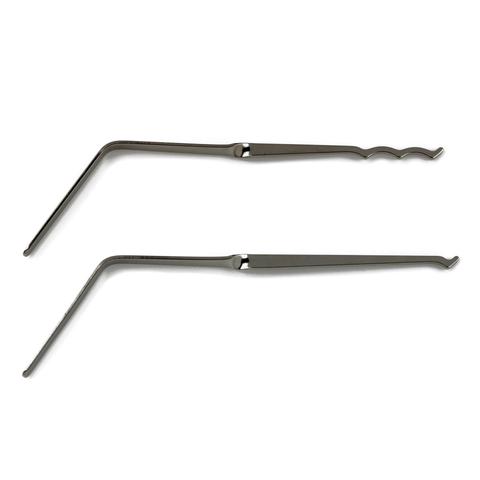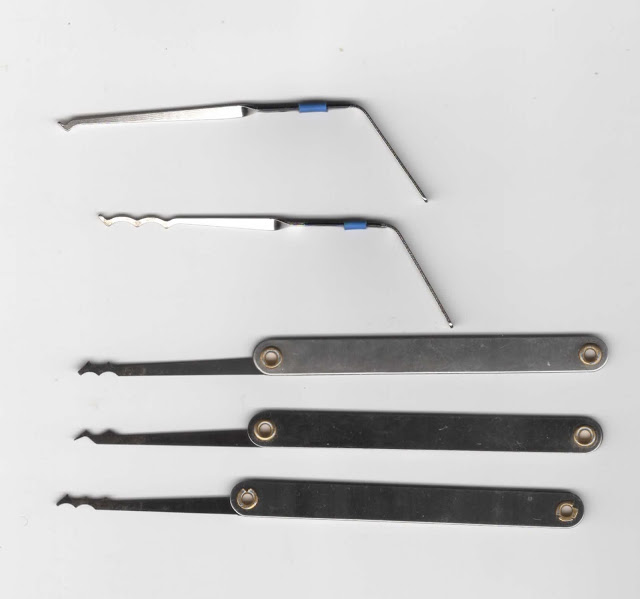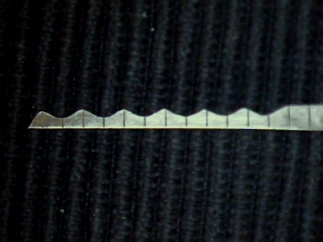I suspect that the readers of my posts on lock-picking fall into two broad camps. The first are those interested in lock sport, and that, like me, are relatively new to the field. The second are those who are not particularly interested in lock sport as a hobby but wish to add a new capability to their repertoire of survival, self-reliance and preparedness skills.
To both groups, I give the same initial advice: If you only ever buy or carry one set of lock picks, it should be the Bogotas!


As I have mentioned elsewhere, the Bogotas are the invention of a lock sportsman called “Raimondo”. You may see similar picks under other names, which is often an indication that the maker is trying to avoid copyright and IP.
There are number of options when it comes to Bogotas.
In addition to stainless steel, they can also be found in non-magnetic titanium. Interestingly, some of my steel Bogatas are strongly magnetic, others much less so. More of that later.
“Mini-Bogatas” have a shorter handle. The actual pick part is the same, don’t think these are better suited for smaller locks. Mini-Bogatas can be found in either stainless steel or titanium.
Two-hump and four-hump versions of Bogotas can also be found. I have no personal experience of these, so this article will be about the more commonly found triple and single hump set
Another option you will encounter is “standard” or “euro-twist”. This reflects that in the US cylinder locks are usually mounted with the pins uppermost, while in Europe they can be encountered with the pins down or up. A “euro-twist” Bogata has the humps pointing in the same direction as the handle curves. Even if you are in the USA, I suggest you buy “euro-twist” if you can get them. If you are using the other pick as a turning tool, this lets them curve away from each other, giving you a bit more room. There are also flat “no-twist” Bogotas.
Most paired sets of Bogota picks have handles designed to act as a turning tool for the other. And they work very well for this too! I often reach for them before other turning tools when using other picks. It is possible these handles might serve as shims. Regrettably I do not have any handcuffs to experiment with.
The single hump version can serve as a half-diamond or probably as a hook too. This form is sometimes called a “knuckle” or “p-nuckle”. I’ve not made much use of the single-hump as a hook, but have SPP picked locks using it as a half-diamond. The single hump is also good as a skeleton key for small warded locks and can be used to pick dimple locks.
I have seldom actually needed to use the single hump for SPP, since the triple hump rake is the most consistently performing pick I have used. With the right action, some locks pop in seconds. I have some rakes that open certain locks faster than the Bogotas, but if these do not work the Bogotas usually do the job. I use my Bogota rake more than any other pick I have. My other rakes are mainly for locks that are too small for the Bogota or that I know open faster with another design.
The inventor of the Bogota recommends that the rake be used with a jittery action, “like you have had too much coffee”. The Bogota rake actually lends itself to a variety of techniques. I generally start with a see-saw rocking action that becomes a scrubbing action if the lock does not yield. I guess that might qualify as a jiggling or jittery action. You can also use the Bogota with a zipping action. I have even opened some locks with the rake inverted so that the bumps rather than the peaks contact the pins.
I now have a couple of variants of Bogotas. In addition to my original Dangerfield pair, I have a more conventionally handled version from the Dangerfield Serenity set. I also have some pairs from Mad Bob. The Dangerfields have taken up residence in my lock sport kit, while the Mad Bobs I intend to place in an emergency kit.
The Dangerfield pair are not as flexible as some picks out there, which is a good thing since when you are starting out you may get some locks to open with a lateral jiggle. These Bogatas seem unlikely to bend or break with such applications, although as your finesse develops you tend to drop this technique.
The flat-handled Bogota from the Serenity kit seems more flexible than the other Dangerfields. According to UK Bump Keys, all three are 0.022" (0.558mm). Initially, I found the Serenity Bogata easier to use in the narrow twisty keyway of an SKS lock. This has been cured with practice and I now have no trouble using the stiffer Dangerfields in this lock. I actually prefer these Bogotas over the others I currently have.
The Mad Bob Bogotas are offered in both “standard” and “euro-twist” configurations and in both 0.6mm and 0.8mm thicknesss. Mine are 0.6mm euro-twist. They seem a little more flexible than the paired Dangerfield. That is not a bad thing for narrow keyways once you have learnt to be gentle with your picks. Interestingly, the steel used on the Mad Bobs does not seem to be magnetic, while that on the Dangerfields is. I’d not try taking them through a metal detector, but this might be significant if you plan to magnetize your picks to make an emergency compass.
I have seen it said that Mad Bob picks need additional sanding. The picks I have have no detectable rough spots and the finish seems adequate.
The Mad Bobs are somewhat cheaper than the Dangefields, although this is somewhat offset by the shipping and handling charge the former has. Mad Bob also failed to notify me when the picks were back in stock.
I discovered something interesting while trying out my newly arrived Mad Bobs. My stubborn little Abus padlock refused to open. Usually it opens with a Bogota, although the Octo-rake is quicker. The problem seemed to be with which turning tool I used. Using another Mad Bob Bogata pick as a turner seemed to leave insufficient room inside the small keyway for the rake to rock. When using the Dangerfield and Serenity Bogotas stored in my lock sport kit, I must have used the “L” tool in the kit.
My attempted solution was to cut the handle down to about half an inch (12-13mm). I achieved this by cutting a grove with the cut-off disc of a Dremel, then bending it until it sheared. Use something like the stone of a Dremel to re-shape the end then finish with a needle file and abrasive paper. This increases the pick’s capability as a turning tool but makes it more compact, intermediate between the unmodified pick and the often much more expensive 2" mini-Bogota. Bending the handle to a right angle decreases the overall length further and may make them easier to carry in certain locations. On the other hand, the 60 degree bend of the original may be better at reaching recessed locks, and I am not convinced that shortening the handle has that significant an effect on stowage. If your lock pick kits do not contain a Bogota bent as shown, it is worth making a turning tool with a 60 degree bend.

Despite these efforts, the Abus won’t open unless certain turning tools are used on it. Specifically, the Dangerfield Bogotas and Sohos or the Serenity L-tool. The Mad Bobs are either thinner or more flexible. They work fine on other locks I have tried, but the Abus remains a baffling exception. I later hit upon a simple solution.

This image shows some “batarang” rakes (aka w-rakes) that at first glance may appear to be Bogotas. These are from one of my Chinese pick kits, which seem to have been “inspired” by an American brand called “Majestic”. Note that some of them lack the undercutting of some peaks: a feature that strengthens the Bogotas. Also note that the “wavelength” of the peaks is less. They do work, I have opened locks with them, but they are not as good as Bogotas. Incidentally, these particular examples have a number of burrs that could be sanded off, but this is likely to remove the nasty black finish that shows up the brass. I have not experience of genuine Majestic picks but expect they are better finished.
The mirror finish of other picks helps them move around inside a lock and does not show up brass marks like some other pick finishes.

An honourable mention goes to this rake, which is effectively a Bogota without the innovation of the undercuts. The original Bogotas were made from the steel blades from a streetsweeper, illustrating that these are a relatively simple construction project for those with hand tools, material and patience.

A pair of Bogotas constitutes a compact but very capable lock-picking capability. In other posts I have shown how a pair can be carried using the spring from a cheap pen. The safety pin lets the pair be carried where they are concealed or most convenient. An alternate method uses a few inches of gutted paracord. A safety pin may be added with a needle and thread.
If you are new to lock-picking, the Bogotas are great for building your confidence and teaching you finesse.
Given their performance, quality and versatility, a pair of Bogotas are great value for money and worth adding to you tool kit, survival kit etc. Newbie or veteran, you should give them a try!